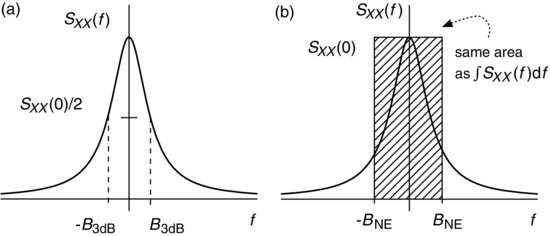8.11 BANDWIDTH
In Section 8.10, we described a bandlimited white-noise process where its PSD has been modified by a filter such that it is nonzero only in the frequency range ![]() . This ideal spectrum can be represented by the rectangle function:
. This ideal spectrum can be represented by the rectangle function:
(8.206) ![]()
whose autocorrelation is the sinc function in (8.194). Obviously not all PSDs have such a well-defined bandwidth. For example, Figure 8.19 shows the PSD of the exponential autocorrelation function RXX(τ) = exp(−α |τ |) given by
Figure 8.19 PSD for an exponential autocorrelation function. (a) 3-dB bandwidth. (b) Noise-equivalent bandwidth.

where α >0. For this type of PSD, we can define an effective bandwidth. This approach is often taken in filter design where the one-sided bandwidth B (positive frequencies) is defined such that the transfer function satisfies
(8.208) ![]()
If |H(f)|2 is expressed in dB, then the cutoff frequencies have a magnitude squared that is 3 dB below the maximum at f = 0. We can apply a similar definition ...
Get Probability, Random Variables, and Random Processes: Theory and Signal Processing Applications now with the O’Reilly learning platform.
O’Reilly members experience books, live events, courses curated by job role, and more from O’Reilly and nearly 200 top publishers.

